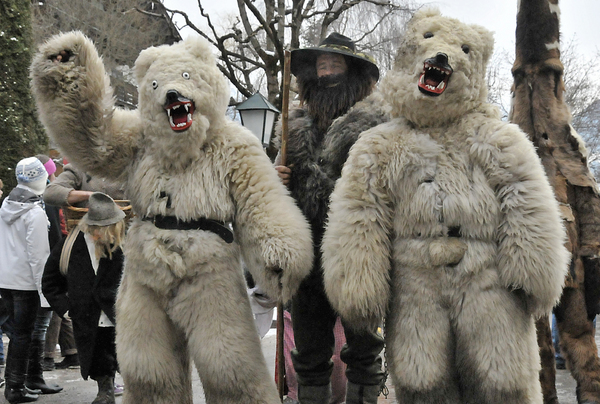"Perchten" in Gastein
Social practices in Salzburg, inscribed 2011
The Gastein Perchten Run is held every four years on one day between New Year’s Day and Epiphany in the area surrounding Bad Gastein and Bad Hofgastein, in Salzburg province. The roughly 140 figures who participate in the run include not only the Three Kings, buffoons, grinders, witches, devils and “Perchten” [characters that are said to derive from the ancient goddess Frau Percha], but also about 30 “cap-wearers”, who bear headdresses often several metres high.
The “cap-wearers” customarily bring to the spectators along the way best wishes and blessings in the form of a brief dance and a bow at the command of the “Perchten captain”. Because of the large number of participants and the long distance they cover, the Gastein Perchten Run is one of the biggest events of its kind in the Alpine region. It is immensely popular with the local population and represents an integral part of Gastein’s yearly calendar as well as an identification symbol for the people of the region. The event is organised by the Gastein Perchten Association, which ensures that it is held at regular intervals of every four years.
This tradition is passed down in an oral form from one generation to the next and through entry into the Gastein Perchten Association. The association members assume various functions and responsibilities in the procession depending on their age and number of years as a member and successively attain higher and higher levels within the hierarchy, with the “cap-wearers” enjoying particularly high esteem in this regard. Due to the great significance of the Perchten Run for the local inhabitants, there is a sufficient number of young successors.
The origins of the Gastein Perchten Run can be traced all the way back to the Renaissance. Over the centuries, the Perchten Run was on several occasions the target of prohibitions by secular and church authorities. The event began being held on a regular basis only at the turn of the 20th century. The design of the costumes and the number of participants have been subject to constant change since that time.
Contact
Downloads
- Application form (in German only) 105 KB (doc)
- Expertise Gruber (in German only) 862 KB (pdf)
- Expertise Hochwarter (in German only) 651 KB (pdf)
- Expertise Krisch (in German only) 501 KB (pdf)


![[Translate to EN:] © J. Ségur/ZED, with the permission of UNESCO](/fileadmin/_processed_/d/b/csm_Convention-2003-IKE_0832a6a47d.jpg)
![[Translate to EN:] © ÖUK](/fileadmin/_processed_/3/9/csm_P1011318_7eac86402f.jpg)

![[Translate to EN:] © Weitblickfilm](/fileadmin/_processed_/9/8/csm_Workshop_17_2dee1e1fd8.jpg)